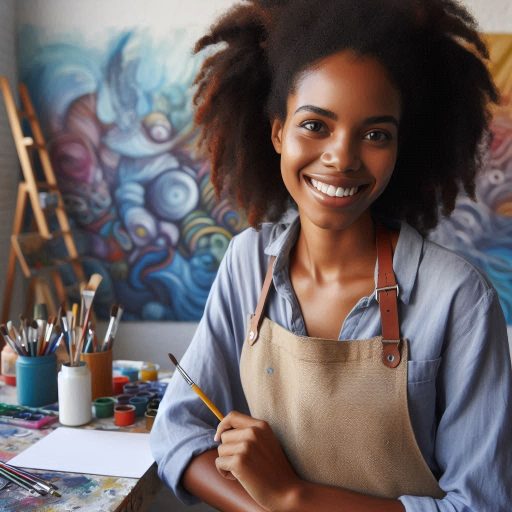Introduction
Murals are large-scale artworks painted directly onto walls or ceilings in public or private spaces.
They serve as visual expressions that can transform the atmosphere of a room or community.
Balancing creativity and client expectations in mural projects is crucial for ensuring that the final piece resonates with both the artist’s vision and the client’s needs.
It is a delicate dance that requires clear communication and collaboration between the artist and the client.
When artists successfully strike this balance, the result is a mural that not only showcases their creative talents but also fulfills the client’s objectives.
This harmony can lead to a more meaningful and impactful work of art that enhances the space it occupies.
Clear communication with the client is key in understanding their expectations and incorporating them into the creative process.
It is essential to listen carefully to their vision and feedback while also presenting innovative ideas that align with the overall project goals.
By finding the right balance between creativity and client expectations, artists can create murals that not only captivate viewers but also satisfy the client’s desires.
This collaborative approach can lead to a successful and fulfilling mural project that exceeds everyone’s expectations.
Understanding Client Expectations
The initial consultation process with clients to understand their vision
The initial consultation sets the foundation for a successful mural project.
During this meeting, I ask clients about their vision.
I encourage them to share their ideas, themes, and color preferences.
I also inquire about the mural’s intended location and audience.
This information helps me tailor my artistic approach.
Visual aids, such as sketches or mood boards, can clarify concepts.
I suggest clients provide examples of murals they admire.
This process fosters collaboration and aligns our creative goals.
The significance of clear communication and active listening to meet client expectations
Clear communication is vital in the mural creation process.
It ensures that both artist and client share the same vision.
Transform Your Career Today
Unlock a personalized career strategy that drives real results. Get tailored advice and a roadmap designed just for you.
Start NowI practice active listening by paraphrasing client ideas.
This technique shows clients that I value their input.
Regular updates throughout the project build trust and transparency.
I encourage clients to voice concerns or suggestions at any stage.
This openness allows for adjustments before the final reveal.
Establishing a feedback loop enhances client satisfaction.
I invite clients to review sketches and color choices.
Their input shapes the final design, ensuring it reflects their expectations.
Clear communication minimizes misunderstandings and fosters a positive working relationship.
In short, understanding client expectations is crucial in mural projects.
The initial consultation and active listening lead to a shared vision.
This approach not only enhances creativity but also meets client needs effectively.
Engaging clients in the process builds trust and satisfaction.
By prioritizing communication, I create murals that resonate with clients and their audiences.
Read: Inspirational Glass Art Design Ideas
Flexibility in Creative Process
Incorporating Client Feedback
When receiving feedback, listen actively and understand their vision.
Consider their suggestions while staying true to your artistic style.
Communicate openly and discuss how to merge both perspectives effectively.
Show them mock-ups or sketches to visualize the proposed changes.
Collaborate with the client to ensure the mural reflects their expectations.
Transform Your Career Today
Unlock a personalized career strategy that drives real results. Get tailored advice and a roadmap designed just for you.
Start NowBenefits of Adjustments and Revisions
Embrace changes as opportunities to enhance the final outcome.
Increased client satisfaction by meeting their specific requirements.
Improves communication and strengthens the client-artist relationship.
Enhances your skills by adapting to different preferences and styles.
Allows for a more dynamic and collaborative creative process.
Read: Collaborating with Communities on Mural Projects
Setting Realistic Expectations
The importance of managing client expectations from the beginning
Managing client expectations is crucial for a successful mural project.
From the beginning, clear communication establishes a positive relationship.
Clients often have specific visions and timelines, which may not align with reality.
By discussing limitations and possibilities upfront, you create a foundation of trust.
Transparency helps prevent misunderstandings that can lead to disappointment.
Examples of how to set achievable timelines and goals for the project
Setting achievable timelines is essential for keeping the project on track.
Break down the mural process into clear stages, such as design, approval, and execution.
For instance, a design phase may take one to two weeks, depending on complexity.
After that, allocate time for client feedback and revisions.
This structured approach allows clients to visualize the timeline clearly.
When discussing goals, it‘s vital to align them with the client‘s vision.
For example, if a client desires a mural in a busy area, clarify that weather conditions may cause delays.
Discussing potential hurdles prepares clients for unexpected changes.
Emphasizing flexibility can alleviate pressure and maintain project momentum.
Transform Your Career Today
Unlock a personalized career strategy that drives real results. Get tailored advice and a roadmap designed just for you.
Start NowUse realistic examples to illustrate your points.
Share a past project where an overly ambitious timeline led to stress.
Explain how adjusting the timeline resulted in a more satisfying outcome for both parties.
This not only highlights your expertise but also reassures clients that their satisfaction is your priority.
Regularly updating clients on progress is vital.
Schedule check-ins to discuss any changes or adjustments needed.
This proactive communication fosters collaboration and keeps clients engaged.
Ultimately, setting realistic expectations enhances the mural experience for everyone involved.
Balancing creativity and client needs ensures a successful mural that both you and the client can be proud of.
Read: Glass Art vs. Traditional Art Forms

Collaboration and Compromise
The value of collaboration between the artist and the client
Creating impactful murals requires a strong partnership between the artist and the client.
Collaboration is essential for achieving a shared vision.
Open communication fosters trust and understanding.
Artists must actively listen to clients‘ ideas and concerns.
This engagement helps artists grasp the client’s expectations and goals.
Regular meetings can streamline the creative process.
During these discussions, artists can present initial concepts.
Clients can provide feedback, which guides the direction of the mural.
This iterative process allows both parties to refine their ideas.
It ensures that the final design resonates with the client‘s vision.
Transform Your Career Today
Unlock a personalized career strategy that drives real results. Get tailored advice and a roadmap designed just for you.
Start NowStrategies for finding common ground and compromising when necessary
Finding common ground is crucial when opinions differ.
Artists should be flexible and willing to adapt their style.
Meanwhile, clients must also consider the artist‘s expertise.
Both parties should approach the discussion with an open mind.
Identifying overlapping interests can lead to creative solutions.
When compromises are necessary, focus on core values.
Discuss which elements are non-negotiable for both sides.
This clarity helps navigate potential conflicts.
Artists can suggest alternatives that still align with the client‘s goals.
For example, if a color palette doesn’t meet expectations, artists can propose variations that honor the original intent.
Another strategy involves creating mock-ups.
Visual representations allow clients to envision changes without committing to a final design.
This technique can reduce misunderstandings and enhance satisfaction.
Basically, successful murals arise from a balanced blend of creativity and client expectations.
Collaboration and compromise are key components in this process.
By valuing each other’s perspectives, artists and clients can create murals that fulfill artistic ambitions and meet client needs.
This synergy results in beautiful, meaningful art that enhances any space.
Read: Exploring Modern Glass Art Trends
Uncover the Details: Balancing Art and Function in Furniture Design
Personal Fulfillment vs. Client Satisfaction
Balancing Personal Creativity and Client Demands
As an artist, expressing personal creativity is vital.
Transform Your Career Today
Unlock a personalized career strategy that drives real results. Get tailored advice and a roadmap designed just for you.
Start NowHowever, client expectations often shape the final outcome.
Finding the right balance is essential.
Engaging in open dialogue with clients helps clarify their vision.
This understanding allows artists to incorporate personal style while meeting specific demands.
Setting boundaries is crucial; artists should feel free to suggest innovative ideas.
By combining personal flair with client requirements, artists can create murals that resonate with both parties.
This balance fosters a collaborative atmosphere, enhancing the creative process.
The Satisfaction of Successful Collaboration
Achieving a successful collaboration brings immense satisfaction.
When artists and clients work together, they build a shared vision.
This partnership often leads to meaningful murals that reflect both perspectives.
Seeing a concept evolve through teamwork creates a sense of accomplishment.
Artists feel fulfilled when their creativity aligns with client goals.
This alignment not only meets client expectations but also elevates the artwork.
The resulting mural often tells a story, resonating with viewers on multiple levels.
All in all, the satisfaction of creating impactful art lies in the collaborative effort.
Both personal fulfillment and client satisfaction are vital to an artist’s journey.
Striking this balance enhances the creative process and leads to memorable murals.
The journey of collaboration fosters growth and inspires new ideas.
Navigating the tension between personal creativity and client demands is essential for artists.
Embracing this duality leads to fulfilling artistic expressions and satisfied clients.
Transform Your Career Today
Unlock a personalized career strategy that drives real results. Get tailored advice and a roadmap designed just for you.
Start NowA successful mural can encapsulate the essence of this relationship, showcasing both individual creativity and collaborative success.
Overcoming Challenges in Balancing Creativity and Client Expectations in Murals
Creating murals often presents challenges in balancing artistic vision with client expectations.
Understanding these challenges can help artists navigate the process effectively.
Common Challenges in Balancing Creativity and Client Expectations
One common challenge is differing visions.
Clients may have specific ideas that conflict with the artist’s style.
This can lead to frustration for both parties.
Additionally, tight deadlines can stifle creativity.
Artists may feel pressured to produce quickly, sacrificing quality and innovation.
Budget constraints can also pose challenges.
Limited resources might restrict the materials an artist wants to use.
Furthermore, clients might have unrealistic expectations regarding the project‘s scope.
This misalignment can create tension and hinder the creative process.
Solutions and Strategies for Overcoming Obstacles
To overcome these challenges, clear communication is vital.
Artists should discuss ideas thoroughly during the initial consultation.
Listening to the client‘s vision while expressing artistic insights can lead to a productive dialogue.
Creating a flexible design proposal can help manage expectations.
Presenting multiple concepts allows clients to choose elements they like while respecting the artist’s creativity.
Setting realistic timelines is crucial.
Artists should establish milestones that allow time for revisions without compromising quality.
Using mock-ups can bridge the gap between creativity and expectations.
Transform Your Career Today
Unlock a personalized career strategy that drives real results. Get tailored advice and a roadmap designed just for you.
Start NowVisual representations help clients visualize the final product.
This approach minimizes misunderstandings and fosters collaboration.
Lastly, maintaining a positive attitude throughout the project is essential.
Embracing flexibility can lead to unexpected creative solutions.
By focusing on teamwork, artists can transform challenges into opportunities for growth.
Overcoming challenges in balancing creativity and client expectations requires effective communication, flexibility, and collaboration.
Artists can deliver stunning murals that satisfy both their vision and their clients’ needs.
Conclusion
When it comes to mural projects, finding a balance between creativity and client expectations is essential for a successful outcome.
By prioritizing communication, flexibility, and collaboration, artists can ensure that their artistic vision aligns with the client’s desires and expectations.
It is crucial to maintain open lines of communication throughout the project, discussing ideas and addressing any concerns or feedback from the client.
This helps to avoid misunderstandings and ensures that both parties are on the same page.
Flexibility is key when working on mural projects, as clients may have specific preferences or changes they want to make along the way.
Artists should be open to adjusting their designs and incorporating client feedback to meet their expectations.
Collaboration is also vital in achieving successful outcomes in mural projects.
By actively involving the client in the creative process, artists can create a sense of ownership and ensure that the final piece resonates with the client’s vision.
Finding the right balance between creativity and client expectations requires a careful and thoughtful approach.
By embracing communication, flexibility, and collaboration, artists can create stunning murals that not only showcase their artistic talent but also exceed the client’s expectations.




